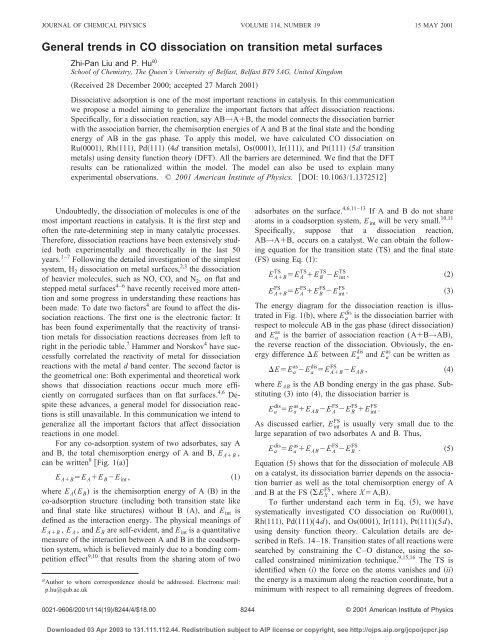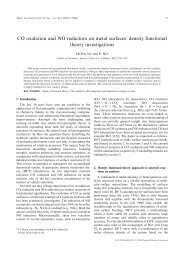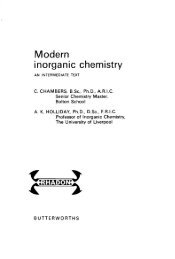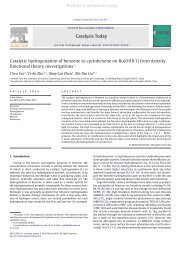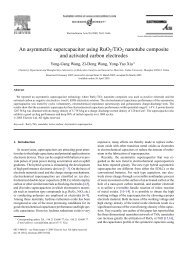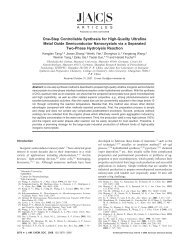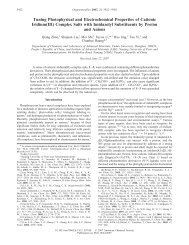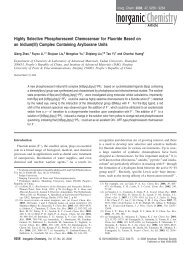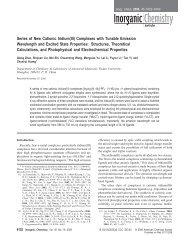J. Chem. Phys. 2001, 115, 609.(PDF)
J. Chem. Phys. 2001, 115, 609.(PDF)
J. Chem. Phys. 2001, 115, 609.(PDF)
Create successful ePaper yourself
Turn your PDF publications into a flip-book with our unique Google optimized e-Paper software.
JOURNAL OF CHEMICAL PHYSICS VOLUME 114, NUMBER 19 15 MAY <strong>2001</strong><br />
General trends in CO dissociation on transition metal surfaces<br />
Zhi-Pan Liu and P. Hu a)<br />
School of <strong>Chem</strong>istry, The Queen’s University of Belfast, Belfast BT9 5AG, United Kingdom<br />
Received 28 December 2000; accepted 27 March <strong>2001</strong><br />
Dissociative adsorption is one of the most important reactions in catalysis. In this communication<br />
we propose a model aiming to generalize the important factors that affect dissociation reactions.<br />
Specifically, for a dissociation reaction, say AB→AB, the model connects the dissociation barrier<br />
with the association barrier, the chemisorption energies of A and B at the final state and the bonding<br />
energy of AB in the gas phase. To apply this model, we have calculated CO dissociation on<br />
Ru0001, Rh111, Pd111 4d transition metals, Os0001, Ir111, and Pt111 5d transition<br />
metals using density function theory DFT. All the barriers are determined. We find that the DFT<br />
results can be rationalized within the model. The model can also be used to explain many<br />
experimental observations. © <strong>2001</strong> American Institute of <strong>Phys</strong>ics. DOI: 10.1063/1.1372512<br />
Undoubtedly, the dissociation of molecules is one of the<br />
most important reactions in catalysis. It is the first step and<br />
often the rate-determining step in many catalytic processes.<br />
Therefore, dissociation reactions have been extensively studied<br />
both experimentally and theoretically in the last 50<br />
years. 1–7 Following the detailed investigation of the simplest<br />
system, H 2 dissociation on metal surfaces, 2,3 the dissociation<br />
of heavier molecules, such as NO, CO, and N 2 , on flat and<br />
stepped metal surfaces 4–6 have recently received more attention<br />
and some progress in understanding these reactions has<br />
been made. To date two factors 4 are found to affect the dissociation<br />
reactions. The first one is the electronic factor: It<br />
has been found experimentally that the reactivity of transition<br />
metals for dissociation reactions decreases from left to<br />
right in the periodic table. 7 Hammer and Norskov 4 have successfully<br />
correlated the reactivity of metal for dissociation<br />
reactions with the metal d band center. The second factor is<br />
the geometrical one: Both experimental and theoretical work<br />
shows that dissociation reactions occur much more efficiently<br />
on corrugated surfaces than on flat surfaces. 4,6 Despite<br />
these advances, a general model for dissociation reactions<br />
is still unavailable. In this communication we intend to<br />
generalize all the important factors that affect dissociation<br />
reactions in one model.<br />
For any co-adsorption system of two adsorbates, say A<br />
and B, the total chemisorption energy of A and B, E AB ,<br />
can be written 8 Fig. 1a<br />
E AB E A E B E int ,<br />
1<br />
where E A (E B ) is the chemisorption energy of A B in the<br />
co-adsorption structure including both transition state like<br />
and final state like structures without B A, and E int is<br />
defined as the interaction energy. The physical meanings of<br />
E AB , E A , and E B are self-evident, and E int is a quantitative<br />
measure of the interaction between A and B in the coadsorption<br />
system, which is believed mainly due to a bonding competition<br />
effect 9,10 that results from the sharing atom of two<br />
a Author to whom correspondence should be addressed. Electronic mail:<br />
p.hu@qub.ac.uk<br />
adsorbates on the surface. 4,6,11–13 If A and B do not share<br />
atoms in a coadsorption system, E int will be very small. 10,11<br />
Specifically, suppose that a dissociation reaction,<br />
AB→AB, occurs on a catalyst. We can obtain the following<br />
equation for the transition state TS and the final state<br />
FS using Eq. 1:<br />
TS<br />
E AB E TS A E TS B E TS int ,<br />
2<br />
FS<br />
E AB E FS A E FS B E FS int .<br />
3<br />
The energy diagram for the dissociation reaction is illustrated<br />
in Fig. 1b, where E dis a is the dissociation barrier with<br />
respect to molecule AB in the gas phase direct dissociation<br />
and E as a is the barrier of association reaction (AB→AB,<br />
the reverse reaction of the dissociation. Obviously, the energy<br />
difference E between E dis a and E as a can be written as<br />
EE as a E dis FS<br />
a E AB E AB ,<br />
4<br />
where E AB is the AB bonding energy in the gas phase. Substituting<br />
3 into 4, the dissociation barrier is<br />
E dis a E as a E AB E FS A E FS B E FS int .<br />
As discussed earlier, E FS int is usually very small due to the<br />
large separation of two adsorbates A and B. Thus,<br />
E a dis E a as E AB E A FS E B FS .<br />
Equation 5 shows that for the dissociation of molecule AB<br />
on a catalyst, its dissociation barrier depends on the association<br />
barrier as well as the total chemisorption energy of A<br />
and B at the FS E X FS , where XA,B.<br />
To further understand each term in Eq. 5, we have<br />
systematically investigated CO dissociation on Ru0001,<br />
Rh111, Pd111(4d), and Os0001, Ir111, Pt111(5d),<br />
using density function theory. Calculation details are described<br />
in Refs. 14–18. Transition states of all reactions were<br />
searched by constraining the C–O distance, using the socalled<br />
constrained minimization technique. 9,15,16 The TS is<br />
identified when i the force on the atoms vanishes and ii<br />
the energy is a maximum along the reaction coordinate, but a<br />
minimum with respect to all remaining degrees of freedom.<br />
5<br />
0021-9606/<strong>2001</strong>/114(19)/8244/4/$18.00 8244<br />
© <strong>2001</strong> American Institute of <strong>Phys</strong>ics<br />
Downloaded 03 Apr 2003 to 131.111.112.44. Redistribution subject to AIP license or copyright, see http://ojps.aip.org/jcpo/jcpcr.jsp
J. <strong>Chem</strong>. <strong>Phys</strong>., Vol. 114, No. 19, 15 May <strong>2001</strong> General trends in CO dissociation on transition metal surfaces<br />
8245<br />
TABLE I. Structural parameters of the TSs for CO dissociations on 4d and<br />
5d transition metals. d C1 , d C2 , d C3 , d O1 , d O2 , and d CO are labeled in Fig.<br />
2. The unit of distance is Å.<br />
d C1 d C2 d C3 d O1 d O2 d CO<br />
Ru 1.970 1.901 1.950 2.084 2.151 1.838<br />
Rh 1.921 1.909 1.954 2.094 2.066 1.897<br />
Pd 1.883 1.987 1.942 2.095 2.010 2.007<br />
Os 1.901 1.900 2.434 1.821 3.275 2.253<br />
Ir 2.064 1.905 2.000 2.060 2.278 1.870<br />
Pt 2.139 1.893 1.987 2.110 2.133 1.930<br />
FIG. 1. a The energy diagram of a co-adsorption system of A and B. b<br />
The energy diagram of the dissociation of molecule AB. I and II are<br />
direct and precursor-mediated dissociation, respectively. All the terms are<br />
defined in the text.<br />
The lowest energy TSs for CO dissociation on different transition<br />
metal surfaces have been shown in Fig. 2 and their<br />
structural parameters are listed in Table I. Although all the<br />
metal surfaces investigated are close packed, it can be seen<br />
that the TS structures can be quite different, especially in CO<br />
dissociation on Os0001. Nevertheless, there are obvious<br />
common features at the TSs: 1 long stretched distance between<br />
the C and the O at the TSs Table I, which are usually<br />
called ‘‘late TSs,’’ and 2 sharing of bonding with a metal<br />
atom between the C and the O Fig. 2, implying the existence<br />
of bonding competition effect. Our TS geometry on<br />
Pt111 is qualitatively consistent with the estimation from<br />
previous work. 5 All the reaction barriers and each term in<br />
Eq. 5 have been determined and are shown in Table II.<br />
It can be seen that E a dis vary considerably from 0.55 to<br />
2.21 eV on these metals Table II, but there is a correlation<br />
between E a dis and E X FS in each row of the periodic table<br />
investigated. This appears to be evident by the linear regression<br />
fitting E a dis against E X FS for 4d and 5d metals, shown<br />
in Fig. 3. For 4d metals, we obtain E a dis 0.98E X<br />
FS<br />
12.98 while for 5d it is E a dis 1.35E X FS 17.30. A similar<br />
phenomenon has been observed by Hammer for NO<br />
dissociation. 4 Hammer suggested that the apparent long distance<br />
between N and O atoms at the TS is the reason for the<br />
linear relationship TSs behave like FSs. In fact, these results<br />
can be qualitatively explained using Eq. 5. Apparently,<br />
the slope for 4d metals 0.98 agrees well with the<br />
theoretical prediction 1 of Eq. 5 assuming that E a as is<br />
constant. On the other hand, the slope of 1.35 for 5d metals<br />
is substantially lower than 1, indicating that E a as varies<br />
in an opposite trend with E X FS . As can be seen in Table II,<br />
on going from left to right in 5d metals of the periodic table,<br />
E a as increases just in contrast to E X FS . It is this variation of<br />
E a as that lowers the slope of a 5d metal curve to 1.35. In<br />
TABLE II. The energy components of CO dissociations on 4d and 5d<br />
transition metal surfaces. E FS X , E 0 int , E as a and E dis a are defined in the text.<br />
The energy unit is eV.<br />
CO→CO<br />
4d<br />
Ru0001 Rh111 Pd111<br />
FIG. 2. The lowest energy TS structures for CO dissociation on 4d and 5d<br />
transition metals. The big circles are the metal atoms and the hatched one is<br />
the surface atom that bonds with the C and the O simultaneously. The small<br />
white circle is the C atom and the small black one is the O atom. a<br />
Illustrates the TSs on all the metals except Os0001. b Shows the TS on<br />
Os0001. Bond distances between the C and three nearest metal atoms are<br />
labeled as d C1 , d C2 and d C3 , respectively. Bond distances between the O<br />
and two nearest metal atoms are labeled as d O1 and d O2 , respectively. The<br />
distance between the C and the O is labeled as d CO . They are listed in<br />
Table I.<br />
12.47 11.56 11.00<br />
0.36 0.65 1.13<br />
1.87 1.59 1.79<br />
dis<br />
E a<br />
0.55 1.25 2.03<br />
FS<br />
E X<br />
0<br />
E int<br />
as<br />
E a<br />
5d Os0001 Ir111 Pt111<br />
12.18 11.58 11.14<br />
0.27 0.45 1.11<br />
1.74 1.82 2.12<br />
dis<br />
E a<br />
0.79 1.47 2.21<br />
ES<br />
E X<br />
0<br />
E int<br />
as<br />
E a<br />
Downloaded 03 Apr 2003 to 131.111.112.44. Redistribution subject to AIP license or copyright, see http://ojps.aip.org/jcpo/jcpcr.jsp
8246 J. <strong>Chem</strong>. <strong>Phys</strong>., Vol. 114, No. 19, 15 May <strong>2001</strong> Z.-P. Liu and P. Hu<br />
FIG. 3. E x FS vs E a dis on 4d and 5d metal surfaces for CO dissociations.<br />
fact, even for 4d metals E a as is not constant either. The E a as on<br />
Rh is about 0.2 eV lower than that on Ru and Pd, resulting in<br />
the point of Rh being slightly away from the linear line<br />
(E a dis 0.98E X FS 12.98) for 4d metals. Nevertheless, the<br />
changes in E a as are much less pronounced than that in E X FS ,<br />
leading to the apparent linear relationship between the dissociation<br />
barrier and the FS chemisorption energy. 19 In other<br />
words, to a large extent the dissociation reaction barrier is<br />
determined by the FS atomic chemisorption energy for these<br />
systems. This is consistent with the empirical Bronsted–<br />
Polanyi relationship, which indicates the change in reaction<br />
barrier can be correlated with the change in the heat of reaction<br />
as long as the reaction mechanism is unchanged. 20 It<br />
should be stressed that the Bronsted–Polanyi relationship is<br />
only qualitatively correct because E a dis not only depends on<br />
E X FS , but also is related to the E a as Eq. 5. As shown in<br />
Table II for CO dissociation on all the close-packed metal<br />
surfaces investigated, even with the same reaction mechanism<br />
E a as is not constant and hence the relationship between<br />
E a dis and E X FS is not exactly linear.<br />
Since the dissociation barrier also depends on the association<br />
barrier Eq. 5, it is worth discussing the origin of<br />
the association barrier. Using Eqs. 2 and 3, we can write<br />
E a as as<br />
E as FS<br />
a E AB<br />
TS<br />
E AB E A E B E int ,<br />
where E A E FS A E TS A ; E B E FS B E TS TS<br />
B , and E int E int<br />
E FS int E TS int . Obviously, all three terms strongly depend on<br />
the TS geometry. E A (E B ) is further related to the chemisorption<br />
energy of A B at the FS. 21 As E FS A and E FS B increase,<br />
E A and E B should increase. E TS int measures the<br />
bonding competition effect at the TS geometry, which is<br />
metal dependent. To screen off the TS geometry effect on<br />
E TS int , and then to estimate the quantitative trend of bonding<br />
competition effect on different metals, we performed the following<br />
calculations: i optimizing the C and the O in a<br />
separate p(22) unit cell both at hcp hollow sites, respectively,<br />
and calculating their chemisorption energies, namely<br />
E C and E O ; and ii calculating the total chemisorption energy,<br />
E CO , of a C and O coadsorption, in which the C is at<br />
6<br />
a hcp hollow site and the O at the neighboring hcp site 22<br />
thus they share bonding with metal atoms and both are<br />
fixed in structure i. Then we define E 0 int E C E O E CO<br />
0<br />
as the standard interaction energy. All E int are listed in<br />
Table II. It can be seen that as the metal d occupancy increases<br />
from left to right in the periodic table, E int is in-<br />
0<br />
creased. In contrast, E FS X is reduced with the increase of d<br />
occupancy 4 Table II. Therefore, it is these two opposite<br />
trends that result in the overall small change in E as a Eq. 6<br />
compared with that in E dis a . For example, for 5d metals the<br />
change in E as a is 0.38 eV larger than 4d metals, while the<br />
change in E dis a is higher up to 1.41 eV Table II. It should be<br />
noted that the above discussion of bonding competition effect<br />
and E FS X is based on the fact that the reactions studied<br />
here possess late TSs. In this case, it is the bonding competition<br />
effect, not the bonding and antibonding states between<br />
the C and the O, that greatly influences the E TS int .<br />
Based on the understanding presented here, we can explain<br />
many observations for dissociation reactions. For example,<br />
the two important factors that affect the dissociation<br />
barrier, namely the electronic and geometrical factors, 23 can<br />
be rationalized within the present model. The electronic effect<br />
on the dissociation barrier, i.e., the increase of the dissociation<br />
barrier from left to right in the periodic table,<br />
mainly results from the variation of E FS X , as shown in Fig.<br />
2. This chemisorpion energy trend also affects E as a and finally<br />
affects E dis a , but to a much less extent for systems with late<br />
TSs. The geometrical effect on the dissociation barriers, i.e.,<br />
lower dissociation barriers on steps, 6 kinks, and defects than<br />
that on terraces, 4 is mainly a consequence of change in E as a ,<br />
particularly in E TS int . On these corrugated surfaces, the reaction<br />
can achieve such TS structures that two reactants do not<br />
share bonding with metal atoms the dissociation path has<br />
been changed at the corrugated surfaces. As a result, the<br />
bonding competition between the two reactants is small at<br />
the TSs, resulting in a small E int (E TS int ). Thus, the association<br />
barriers, E as a , will be small Eq. 6, leading to finally<br />
lower dissociation barriers.<br />
It is worth mentioning the effect of AB bonding energy<br />
in the gas phase, E AB , on the dissociation barrier. It can be<br />
seen in Eq. 5 that the higher the E AB is, the larger the<br />
dissociation barrier, which is obvious from chemical intuition.<br />
What is not apparent is whether a dissociation reaction<br />
should be a nonactivated one no dissociation barrier or an<br />
activated one and whether a dissociation reaction should occur<br />
through the precursor-mediated mechanism molecules<br />
adsorb molecularly first and then dissociate. The present<br />
model can provide some clues to the answers to these questions.<br />
In Eq. 5, ifE as a E AB E FS x , the reaction is certainly<br />
an activated process; if E as a E AB E FS x , then the<br />
reaction would occur without a barrier nonactivated, otherwise<br />
the reaction should follow a precursor-mediated mechanism<br />
Fig. 1b.<br />
In summary, this work represents one of the first attempts<br />
to generalize a model for dissociation barriers. Specifically,<br />
a model to connect the dissociation barrier to the<br />
association barrier, chemisorption energies at the FS, and the<br />
bonding energy of the molecule is proposed. Using the<br />
present model many observations can be rationalized.<br />
Downloaded 03 Apr 2003 to 131.111.112.44. Redistribution subject to AIP license or copyright, see http://ojps.aip.org/jcpo/jcpcr.jsp
J. <strong>Chem</strong>. <strong>Phys</strong>., Vol. 114, No. 19, 15 May <strong>2001</strong> General trends in CO dissociation on transition metal surfaces<br />
8247<br />
The super-computing center for Ireland is acknowledged<br />
for computer time.<br />
1 G. R. Darling and S. Holloway, Rep. Prog. <strong>Phys</strong>. 58, 1595 1995.<br />
2 J. Harris and S. Andersson, <strong>Phys</strong>. Rev. Lett. 55, 1583 1985.<br />
3 B. Hammer and J. K. Norskov, Surf. Sci. 343, 211 1995.<br />
4 B. Hammer and J. K. Norskov, Adv. Catal. 45, 712000.<br />
5 Y. Morikawa, J. J. Mortensen, B. Hammer, and J. K. Norskov, Surf. Sci.<br />
386, 671997.<br />
6 S. Dahl, A. Logadottir, R. C. Egeberg, J. H. Larsen, I. Chorkendorff, E.<br />
Tornqvist, and J. K. Norskov, <strong>Phys</strong>. Rev. Lett. 83, 1814 1999.<br />
7 R. I. Masel, Principles of Adsorption and Reaction on Solid Surface Interscience,<br />
New York, 1996.<br />
8 A similar equation was used by Hammer as follows, E ts E rebond E int in<br />
B. Hammer, <strong>Phys</strong>. Rev. Lett. 83, 3681 1999; B. Hammer, Surf. Sci. 459,<br />
323 2000.<br />
9 A. Alavi, P. Hu, T. Deutsch, P. L. Silverstrelli, and J. Hutter, <strong>Phys</strong>. Rev.<br />
Lett. 80, 36501998.<br />
10 K. Bleakley and P. Hu, J. Am. <strong>Chem</strong>. Soc. 121, 7644 1999.<br />
11 J. J. Mortensen, B. Hammer, and J. K. Norskov, Surf. Sci. 414, 315<br />
1998.<br />
12 C. J. Zhang, P. Hu, and M.-H. Lee, Surf. Sci. 432, 305 1999.<br />
13 E int may contain other terms, such as the Pauli repulsion. The Pauli repulsion<br />
contribution to E int is important only when A and B are very close<br />
Ref. 11. For the systems concerned in this communication, the distances<br />
between A and B are usually large. In addition, the distances between A<br />
and B at the TSs determined in this study are similar. Therefore, one may<br />
expect that the Pauli repulsion contribution to E int will not change dramatically<br />
from one system to another. In other words, the Pauli repulsion<br />
will not considerably affect the reactivity difference for the systems investigated<br />
in this study.<br />
14 A generalized gradient approximation was utilized in all the calculations<br />
Ref. 17. The electronic wave functions were expanded in a plane wave<br />
basis set and the ionic cores were described by ultrasoft pseudopotentials<br />
Ref. 18. Ru0001, Rh111, Pd111, Os0001, Ir111, and Pt111<br />
were modeled by three layers slabs with all layers fixed at their bulk<br />
positions. The surface relaxation was checked and found to be rather small<br />
less than 0.1 eV. The vacuum region between slabs was 10 Å and a<br />
cutoff energy of 340 eV was used. 331k point sampling for p(2<br />
2) unit cell and 321k point sampling for p(23) unit cell have<br />
been used in calculations. Convergence check has been performed by<br />
increasing k point sampling up to 441 for p(22) slab and 33<br />
1 for p(23) slab. Previous work Refs. 15 and 16 also show that this<br />
setup affords enough accuracy. All the total energy calculations were performed<br />
using CASTEP M. C. Payne, M. P. Teter, D. C. Allan, T. A.<br />
Arias, and J. D. Joannopoulos, Rev. Mod. <strong>Phys</strong>. 64, 1045 1992.<br />
15 A. Michaelides and P. Hu, J. Am. <strong>Chem</strong>. Soc. 122, 9866 2000.<br />
16 C. J. Zhang and P. Hu, J. Am. <strong>Chem</strong>. Soc. 122, 2134 2000.<br />
17 J. P. Perdew, J. A. Chevary, S. H. Vosko, K. A. Jackson, M. R. Pedeson,<br />
D. J. Singh, and C. Fiolhais, <strong>Phys</strong>. Rev. B 46, 6671 1992.<br />
18 D. Vanderbilt, <strong>Phys</strong>. Rev. B 41, 7892 1990.<br />
19 The effect of the approximate linear relationship between E a dis and E X<br />
FS<br />
with a slope around 1 is quite dramatic in some sense. For instance, if<br />
E FS X lowers down by 0.5 eV, then the barrier will increase by 0.5 eV<br />
such chemisorption energy difference can be easily achieved if sulphur<br />
sits at the neighboring site of reaction center Refs. 11 and 12. Thus a<br />
little sulphur addition should suppress the local reactivity of metal surface.<br />
The same explanation is also applicable for the self-poisoning phenomenon<br />
coverage effect, in which as the coverage of the fragments increases,<br />
the dissociation reaction rate decreases quickly due to the considerable<br />
decrease in E FS X .<br />
20 See, e.g., R. A. van Santen and M. Neurock, Catal. Rev. Sci. Eng. 37, 557<br />
1995.<br />
21 E TS A can be approximated as E TS A E 0 f (r 0 r TS ), where E 0 is the chemisorption<br />
energy of A at the optimized position, r 0 , and r TS is the TS<br />
position of A which is near r 0 . Usually E 0 E FS A , thus E A E FS TS<br />
A E A<br />
E FS A 1 f (r 0 r TS ).<br />
22 E 0 int , which is a measure of the bonding competition effect, depends<br />
mainly on how two adsorbates sharing bonding with the top layer metal<br />
atoms. Metal atoms in the second layer have little effect on E 0 int . For<br />
0<br />
example, E int for C on a hcp site and O on a neighboring hcp site on<br />
Pt111 is calculated as 1.10 eV Table II, which is very similar to that for<br />
C on a hcp site and O on a neighboring fcc site 1.19 eV.<br />
23 A. Logadottir, T. H. Rod, J. K. Norskov, B. Hammer, S. Dahl, and C. J. H.<br />
Jacobsen, J. Catal. 197, 229 <strong>2001</strong>.<br />
Downloaded 03 Apr 2003 to 131.111.112.44. Redistribution subject to AIP license or copyright, see http://ojps.aip.org/jcpo/jcpcr.jsp


